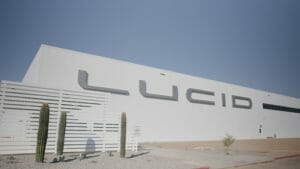State and local officials gathered Wednesday to preview the opening of the new Loop 202 South Mountain Freeway in Phoenix, which adds 22 miles to the metropolitan area’s existing transportation system.
And on Saturday, it officially opened to traffic.
The South Mountain Freeway begins where the existing Loop 202 meets Interstate 10, with southwest Chandler to the east and the Phoenix neighborhood of Ahwatukee to the west, and travels west before turning north through Laveen and reconnecting with I-10 at 59th Avenue.
Gov. Doug Ducey was joined for the announcement by Phoenix Mayor Kate Gallego; Gov. Stephen Roe Lewis of the Gila River Indian Community; John Halikowski, director of the Arizona Department of Transportation; Tempe Mayor Mark Mitchell, who also serves as chairman of the Maricopa Association of Governments; Karla Petty, Arizona division administrator for the Federal Highway Administration; Michael Bidwill, president of the Arizona Cardinals football team; and a number of other local officials, legislators and transportation stakeholders.The announcement, which took place at the new freeway bridges over the Salt River, marks the culmination of the largest single freeway project in Arizona’s history. The project was completed three years ahead of schedule and with $100 million in savings through an “innovative partnership,” according to the Office of the Arizona Governor.
“Decades in the making, this opening marks a historic achievement for Arizona,” Ducey said. “Arizona has benefited from the foresight and innovation of past leaders who have positioned our state as a trade and transportation hub.”
This latest segment of the Loop 202 has been designated the Congressman Ed Pastor Freeway, named in honor of the first Latino elected to represent Arizona in Congress. Pastor passed away last year at 75; members of his family were present for the freeway announcement.
“It took over 30 years to make this dream a reality and a lot of people coming together,” Gallego said. “This will be a major corridor for improved transportation, housing, and high wage jobs. Investing in road infrastructure is so important and part of a regional transit plan that also brings more resources to light rail, buses, walking and biking paths, and safety measures.”
“Arizona has solidified its reputation as a state that is open for opportunity, and as we welcome hundreds of new residents, every day we are making sure our infrastructure remains some of the best in America,” Ducey said. “This Loop 202 opening represents a big step forward in connecting the East and West valleys, as well as prioritizing safety for drivers.”
Loop 202 dates back to 1983, when the proposal for a freeway on the south side of South Mountain was first introduced; it was originally called the Southwest Loop Highway.The transportation corridor has been approved by voters twice as part of the Maricopa Association of Governments’ Regional Transportation Plan — through Proposition 300 in 1985 and Proposition 400 in 2004 — but construction did not begin until 2016, after more than a decade of planning, coordination and study.
“This has been a long time in the making,” said Arizona State Sen. Sean Bowie, LD-18, who was born the year after the freeway was first proposed. “It’s a historic day for Ahwatukee. We’re excited to finally see this freeway open and connect the East Valley to the West Valley and, hopefully, alleviate some of the traffic that folks endure on the I-10 getting back and forth to downtown Phoenix.”
Bowie said that because the freeway project has remained on the table for so long, Ahwatukee residents who purchased their home within the past few decades have been aware of the potential new transportation corridor for a while. He said design changes were made in response to concerns from local residents, including an interchange at 32nd Street, near Desert Vista High School, that was not in the original plans.
“I got a tour of the freeway a couple weeks ago and got to drive the entire stretch of it, and I think when it’s done– I think it’s a pretty nice freeway,” Bowie said. “A lot of folks, I think, are going to be happy with it.”
Bowie said his priority in the coming weeks is to work with ADOT to address lingering issues expressed by local residents.
“This new highway — the largest highway project in state history — represents Arizona’s continued commitment to 21st century infrastructure that will enable our state’s growth for generations to come,” Ducey said. “My thanks go out to the many federal, state, local, tribal and community partners who have worked tirelessly over the past decades to help make this vision a reality.”

|



